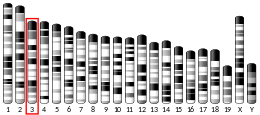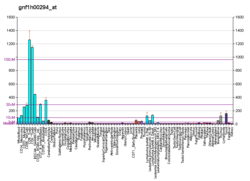PAG1
Phosphoprotein associated with glycosphingolipid-enriched microdomains 1 is a protein that in humans is encoded by the PAG1 gene.[5][6]
The protein encoded by this gene is a type III transmembrane adaptor protein that binds to the tyrosine kinase csk protein. It is thought to be involved in the regulation of T cell activation.[6]
Interactions
PAG1 has been shown to interact with FYN,[5] C-src tyrosine kinase,[5] Sodium-hydrogen antiporter 3 regulator 1[7] and Abl gene.[8]
References
- 1 2 3 GRCh38: Ensembl release 89: ENSG00000076641 - Ensembl, May 2017
- 1 2 3 GRCm38: Ensembl release 89: ENSMUSG00000027508 - Ensembl, May 2017
- ↑ "Human PubMed Reference:".
- ↑ "Mouse PubMed Reference:".
- 1 2 3 Brdicka T, Pavlistova D, Leo A, Bruyns E, Korinek V, Angelisova P, Scherer J, Shevchenko A, Hilgert I, Cerny J, Drbal K, Kuramitsu Y, Kornacker B, Horejsi V, Schraven B (May 2000). "Phosphoprotein associated with glycosphingolipid-enriched microdomains (PAG), a novel ubiquitously expressed transmembrane adaptor protein, binds the protein tyrosine kinase csk and is involved in regulation of T cell activation". J Exp Med. 191 (9): 1591–604. PMC 2213442
 . PMID 10790433. doi:10.1084/jem.191.9.1591.
. PMID 10790433. doi:10.1084/jem.191.9.1591. - 1 2 "Entrez Gene: PAG1 phosphoprotein associated with glycosphingolipid microdomains 1".
- ↑ Brdicková, N; Brdicka T; Andera L; Spicka J; Angelisová P; Milgram S L; Horejsí V (Oct 2001). "Interaction between two adapter proteins, PAG and EBP50: a possible link between membrane rafts and actin cytoskeleton". FEBS Lett. Netherlands. 507 (2): 133–6. ISSN 0014-5793. PMID 11684085. doi:10.1016/S0014-5793(01)02955-6.
- ↑ Wen, S T; Van Etten R A (Oct 1997). "The PAG gene product, a stress-induced protein with antioxidant properties, is an Abl SH3-binding protein and a physiological inhibitor of c-Abl tyrosine kinase activity". Genes Dev. UNITED STATES. 11 (19): 2456–67. ISSN 0890-9369. PMC 316562
 . PMID 9334312. doi:10.1101/gad.11.19.2456.
. PMID 9334312. doi:10.1101/gad.11.19.2456.
Further reading
- Wen ST, Van Etten RA (1997). "The PAG gene product, a stress-induced protein with antioxidant properties, is an Abl SH3-binding protein and a physiological inhibitor of c-Abl tyrosine kinase activity.". Genes Dev. 11 (19): 2456–67. PMC 316562
 . PMID 9334312. doi:10.1101/gad.11.19.2456.
. PMID 9334312. doi:10.1101/gad.11.19.2456. - Brdicková N, Brdicka T, Andera L, et al. (2001). "Interaction between two adapter proteins, PAG and EBP50: a possible link between membrane rafts and actin cytoskeleton.". FEBS Lett. 507 (2): 133–6. PMID 11684085. doi:10.1016/S0014-5793(01)02955-6.
- Strausberg RL, Feingold EA, Grouse LH, et al. (2003). "Generation and initial analysis of more than 15,000 full-length human and mouse cDNA sequences.". Proc. Natl. Acad. Sci. U.S.A. 99 (26): 16899–903. PMC 139241
 . PMID 12477932. doi:10.1073/pnas.242603899.
. PMID 12477932. doi:10.1073/pnas.242603899. - Ota T, Suzuki Y, Nishikawa T, et al. (2004). "Complete sequencing and characterization of 21,243 full-length human cDNAs.". Nat. Genet. 36 (1): 40–5. PMID 14702039. doi:10.1038/ng1285.
- Gerhard DS, Wagner L, Feingold EA, et al. (2004). "The status, quality, and expansion of the NIH full-length cDNA project: the Mammalian Gene Collection (MGC).". Genome Res. 14 (10B): 2121–7. PMC 528928
 . PMID 15489334. doi:10.1101/gr.2596504.
. PMID 15489334. doi:10.1101/gr.2596504. - Tedoldi S, Paterson JC, Hansmann ML, et al. (2006). "Transmembrane adaptor molecules: a new category of lymphoid-cell markers.". Blood. 107 (1): 213–21. PMID 16160011. doi:10.1182/blood-2005-06-2273.
- Jiang LQ, Feng X, Zhou W, et al. (2006). "Csk-binding protein (Cbp) negatively regulates epidermal growth factor-induced cell transformation by controlling Src activation.". Oncogene. 25 (40): 5495–506. PMID 16636672. doi:10.1038/sj.onc.1209554.
- Empty citation (help)
- Roberts AE, Araki T, Swanson KD, et al. (2007). "Germline gain-of-function mutations in SOS1 cause Noonan syndrome.". Nat. Genet. 39 (1): 70–4. PMID 17143285. doi:10.1038/ng1926.
- Smida M, Posevitz-Fejfar A, Horejsi V, et al. (2007). "A novel negative regulatory function of the phosphoprotein associated with glycosphingolipid-enriched microdomains: blocking Ras activation.". Blood. 110 (2): 596–615. PMID 17389760. doi:10.1182/blood-2006-07-038752.
This article is issued from
Wikipedia.
The text is licensed under Creative Commons - Attribution - Sharealike.
Additional terms may apply for the media files.




